Blog made for module ENGL5019: Literature in Time and Space at OBU
Don't wanna be here? Send us removal request.
Text
We have lingered in the chambers of the sea
By sea-girls wreathed with seaweed red and brown
Till human voices wake us, and we drown
-The Lovesong of J. Alfred Prufrock, T.S. Eliot

You sleep that night on a buoyant sea, in his arms, your skin pressed warm against his. You stretch your feet out and half expect to see a rainbow fish tail instead of your toes. - Desperado
10 notes
·
View notes
Text
“I am no prophet — and here’s no great matter.I have seen the moment of my greatness flicker’
Religion in the The Love Song of J. Alfred Prufrock
Reading this long poem requires a lot of focus and concertation to understand all the themes surrounding it. Looking at the opening of the poem, we see an extract from Dante’s inferno. This extract is from when Dante meets Guido in the eighth circle of Hell. Dante tries to figure out what Guido did to end up in this layer of Hell, but he wont say. Guido argues that if he tells Dante, he will go back to earth and write about his atrocities. It is later revealed that he committed awful war crimes and tried to get himself pardoned before his death. His crimes and the attempt to ‘cheat’ God result In him having no body and to live his life as nothing more than a flame.
So why did T. S Elliot include this epigraph in his poem? He wanted us to see the similarities between Guido and Prufrock, and that this poem is a way for Prufrock to confess the deepest parts of his soul. He tries to trick the reader into a confessional type of text. This means that we align the characters of Prufrock and Guido. This section was included to let the readers that not all characters are good, but instead are bad people pretending to be good. This poem is Prufrock’s own personal hell. Hell in the poem is something that Prufrock fears, he doesn’t want his soul to be condemned to hell. So he used the extended poem to act as a confession, he wants to be removed from his evil past in hopes to escape the hell he has found himself in, and the hell he will end up in.
Mentions of the “Michelangelo Room” in the poem relate to the ideas about the Sistine chapel where the ceiling is adorned with paintings and pictures by Michelangelo himself. This line is repeated many times in the play, to highlight just how important it truly is, but just like one of the iconic paintings in the play, He can’t quiet reach whatever it is he really wants. The painting depicts Adam reaching out to the hand of God, them barely able to do so. Prufrock might be trying to reach out of his own personal universe (his mind) in order to touch something greater (the universe), but unfortunately just as the women keep coming and going, as does Prufrock’s focus and he gets lost in the details.
Prufrock exists in a liminal space, he occupies a state where he is neither one thing or another but instead is forced to question everything. We can relate this to the idea of purgatory. That Prufrock isn’t in hell quiet yet, but he is fighting for his soul. The landscapes and the settings in the poem can be argued to represent purgatory, they are all bland and torturous forcing Prufrock to live through some of the more embarrassing moments of his life. In the final stanza of the poem, we see death that finally brings an end to his agony and torture. The use of drowning is significant as in the Christian faith, being submerged in water is truly the only way to be rebirthed and therefore cleaned of your sins. It is noted that Eliot was experiencing religious change in his life converting from Unitarianism to Anglicanism, a large jump in faith. Just as Prufrock is searching for meaning in his life, Eliot was as well.
0 notes
Video
youtube
I just love this poem so much, and I love Anthony Hopkins.
I find this reading a little fast, but still beautiful.
3 notes
·
View notes
Video
2 notes
·
View notes
Text
"The new light above my table is a great improvement. With all this darkness around me I feel less alone"
Light and Dark symbolism in Krapp's Last Tape.
I Must be a bit obsessed with the ideas of light and dark, that’s what we’re looking at again in Krapp’s last trap, a 1958 one act play written by Samuel Beckett. The light and dark in the play are done for a very specific reason. As with all of the other the stage directions they are written to be followed to the letter as to not send any mixed messages. It was said in the earlier runs of the play, Beckett actually sent people into the audience to check that the stage directions were being followed properly they are that specific and important to the plot. The absurdist play is easy to be seen as nothing more than a silly piece of theatre with no deeper meanings but to Beckett it was a work of art. The stage wasn’t a set but was called an instillation much like an art piece would be installed
With single actor and single set performances like Krapp’s last tape the small details are easy to see. We see how light, and dark play a huge part in the bit of Krapp’s life that we do see. Beckett is said to have been inspired by the Persian religion of Manichaeism which focuses on the differences between good and evil and light and dark. It is now classed as a dead religion, but we can still see evidence of it in the play. The darkness is associated with physical and sensual pleasure and the light being closely linked with the intellectual capacity of the mind. This theory of the dichotomy of light versus dark which is central to the play’s theme. There are obviously other reasons why we see the idea of Manichaeism, but we obviously want to focus on the light and dark imagery. There are references to Manichaean symbols
Dark and light have very specific uses in the play, we see that the desk is in a ‘strong white light’ but the ‘rest of the stage [is] in darkness’. These give us as the watcher the impression that Krapp is almost seemingly in an integration but as he is the only character, it must be a form of self-interrogation. He is trying to pull apart his life’s story and get the information he needs. The line of intensive questioning and referring to his younger selves in the 3rd person certainly makes it seem like an interrogation indeed. The solo light also creates a sense of isolation. Just as he is the only character there is only the one spotlight, this creates a sense of isolation and separation from the rest of the world.
One of the other uses of the light and dark seems to come from a sense of insecurity and fear of the unknown. We learn from some of the tapes that Krapp has some alcoholic tendencies and hides these on stage by only drinking in the dark, he hides the behaviours he is ashamed of in the darkness, showing us only the parts of him that he thinks are desirable. He does the same thing with the tapes, skipping past parts that could be considered shameful and only showing things he thinks we want to see. In the ledger he retrieves from the darkness, we see some of the moments in his life that bring him shame, such as his mother’s death.
0 notes
Photo

Samuel Beckett from Krapp’s Last Tape
19 notes
·
View notes
Photo

Henrique Alvim Corrêa’s Illustrations for The War of the Worlds (1906)
385 notes
·
View notes
Text
“I was no longer a master, but an animal among the animals, under the Martian heel”
The theme of evolution in War of the Worlds
The aliens who invade are clearly more evolved than the humans on Earth. These beings that arrive from Mars seem to have a higher level of intelligence than the humans on Earth. We see man as the ultimate predator with all other life forms under its control but when these ‘invaders’ arrive on earth they suddenly assume the position of apex predator. The humans feel threatened by this advancement on the technology they currently have and for the first time ever feel like they are the lesser being. Evolutionism and evolutionary theory have been much debated over the last 200 years and not more than towards the end of Charles Darwin’s life in 1882. Much like other commonly known celebrities and scientists, work is republished and recirculated posthumously, Charles Darwin’s Origin of species being no exception. H.G. Wells was exposed to Darwinism during his school days and converted from Christianity. In his eyes, beginning to understand science as he did, (even going to get a PhD in sciences based on evolutionary research) meant there was no place for a single creator. He shows distain for his old religious beliefs when one of the Martians crushed the church when they invade, showing that when science is involved it triumphs over religion. His argument was that everything on earth is exactly how is meant to be not by design but by millions of years of trial and error.
Unfortunately, this Darwinistic belief system lead to an interest in Eugenics for Wells. He believed that along with evolution, Eugenics was the way forwards for the human race. In War of the worlds, he argued that the Martians are to humans as humans are to beasts. They become nothing and are fully disposable. I think that H G Wells beliefs about Evolution and Eugenics show in his novel War of the Worlds. Wells replaces the superior species with the new modern invention that attempt to wipe out the human race. This new technologically advanced species however get wiped out by a strain of bacteria, showing that despite all of the advancements being made advancements aren’t always untouchable. The irony is that humans have managed to develop a resistance to such bacteria, but their more advanced counterparts haven’t.
The novel forces the new human evolution to occur but not in the biological sense, the Martians have forced a new sense of scientific enquiry but not in the biological sense. The invasion has forced man to think more logically and scientifically. But we see a lack of ‘evolution’ in the way that they deal with the Martians. They fire weapons at it which only angers them. This isn’t the best way to deal with the situation and therefore shows a lack of evolution.
Evolution plays a large role in the novel as the Martians have incredible intelligence and have evolved to life on their own planet and therefore haven’t got the ability to survive on earth, the one thing that is their downfall. The whole of the novel is arguably one of a sped-up natural selection. The people in the novel are better adapted to deal with the bacteria, showing again that the modern man has eventually taken over the modern technology. This evolution is the advantage of man, and survival of the fittest has replaced the need for Eugenics. Just as the bacteria wiped out the unready Martians, the Martians have erased those unworthy or unready humans.
0 notes
Text

From our stacks: Illustration "The Actual Martian," by Warwick Goble, from The War of the Worlds By H. G. Wells. With Illustrations. New York and London: Harper & Brothers, 1898.
137 notes
·
View notes
Text

Currently reading : The Moonstone by Wilkie Collins
39 notes
·
View notes
Text
"That all-potent and all-merciful drug"
The motif of addiction in The Moonstone
Wilkie Collins is recorded to be an Opium Addict; he was prescribed the drug by his doctors to help deal with the pain he experienced due to his Rheumatic gout. He took in the form of Laudanum (opium mixed with alcohol) and even as he tried to go cold turkey, he took large doses and eventually was completely dependent on his medication. This ‘modern’ invention was only able to be accessed by the diagnosis of a doctor, he often blamed his issues on the doctor that made it possible for him to access. Franklin Blake criticises medicine as a key element of the plot, but he himself is addicted to tobacco and has sleepless nights when he attempts to quit cold turkey. When he is given laudanum to help with the insomnia, it causes him to take the moonstone. Despite the use of addiction, drugs aren’t ever shown in a negative light but instead the characters who use drugs are admirable in the novel, they are characters you would be able to look up to. Almost all of the characters are addicted in some way, even those who don’t take drugs are addicted to something, for example Miss Clack is addicted to handing out Christian pamphlets and when she doesn’t do it, she feels unnormal and unsatisfied.
In my opinion, I think that the novel in any capacity wouldn’t be possible without the input of laudanum, we can obviously see that the story wouldn’t happen if the Doctor hadn’t given the drug. Without his addiction to tobacco, the doctor wouldn’t feel the need to prescribe the opium and alcohol concoction. But Wilkie Collins didn’t recall writing lot of The Moonstone meaning that his opium-infused thoughts led to the creation of much of the plot line. Wilkie Collins never wrote in his diary of his Laudanum dreams but instead write them into the story. Ezra Jennings has these nightmares, and it is argued that these dreams are actually his own dreams. To clear his name, Blake teams up with the assistant of the doctor who originally dosed him, opium addict Ezra Jennings, to stage a “bold experiment,” taking opium again and restaging the original theft. In the end, the Moonstone is returned to India and Rachel and Blake are happily married. This happy conclusion is as a result of the use of further drug taking, yet again showing it in a positive light.
I found the drug taking and normalisation of drugs to be slightly off-putting when reading this novel, it seemed as if everything can be blamed on the modern inventions of drugs and prescribed medicines. Wilkie Collins seems to use the novel to help absolve him of any wrong doings and normalise the use of drugs.
0 notes
Photo

Illustration from The Moonstone (1868) by Wilkie Collins - as illustrated by William Sharp. The Three Brahmins, rowing away from the East Indiaman (a sailing ship). Many consider the book to be the first detective novel.
16 notes
·
View notes
Text
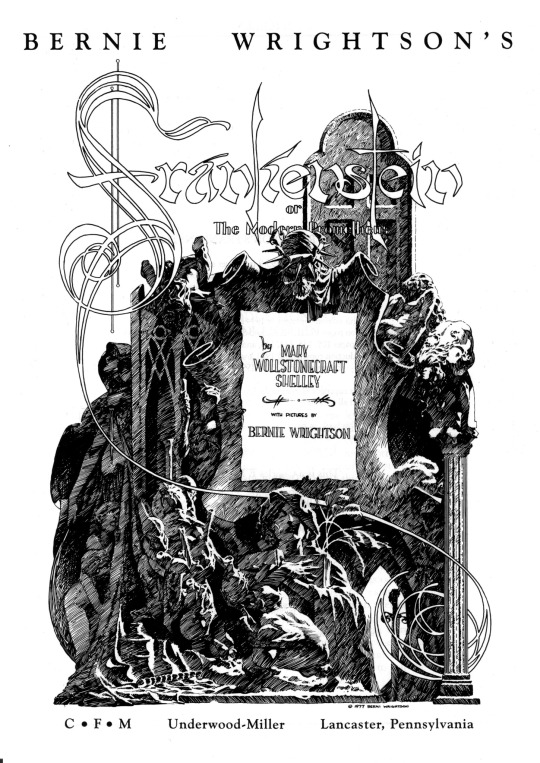
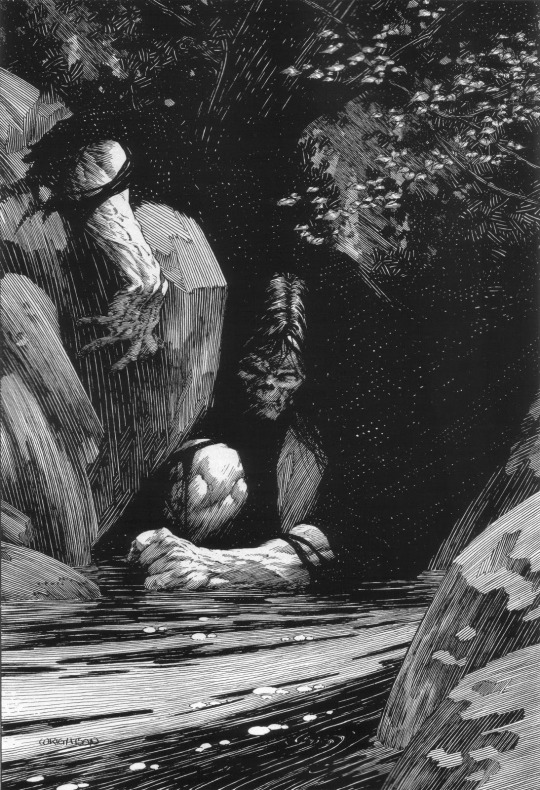
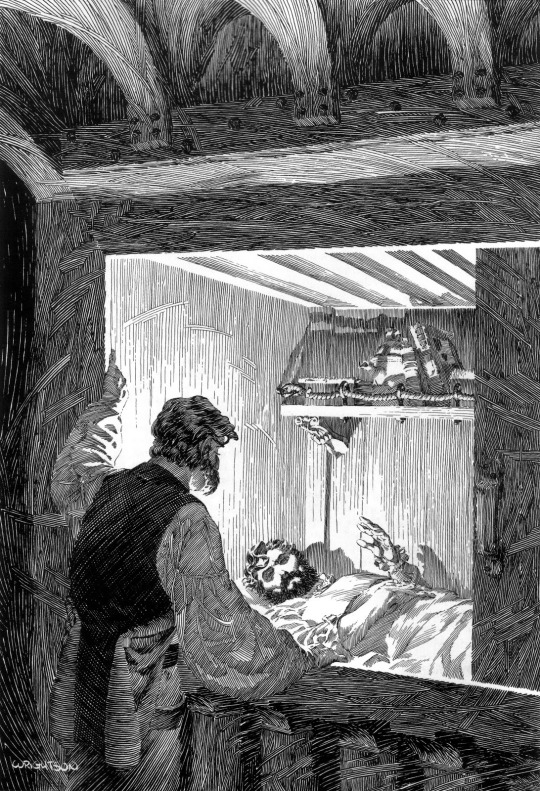

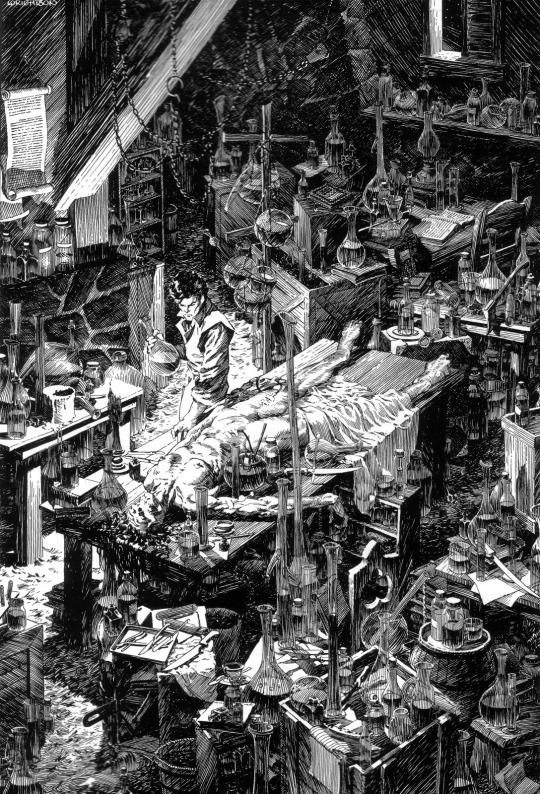
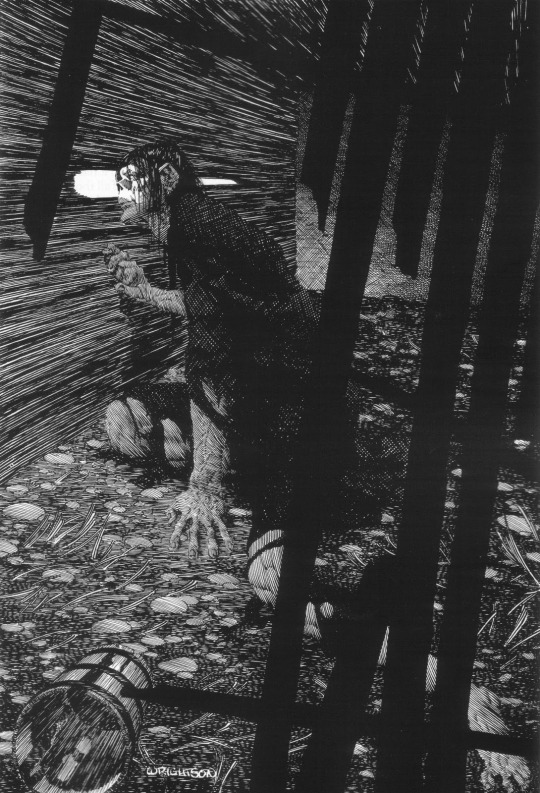


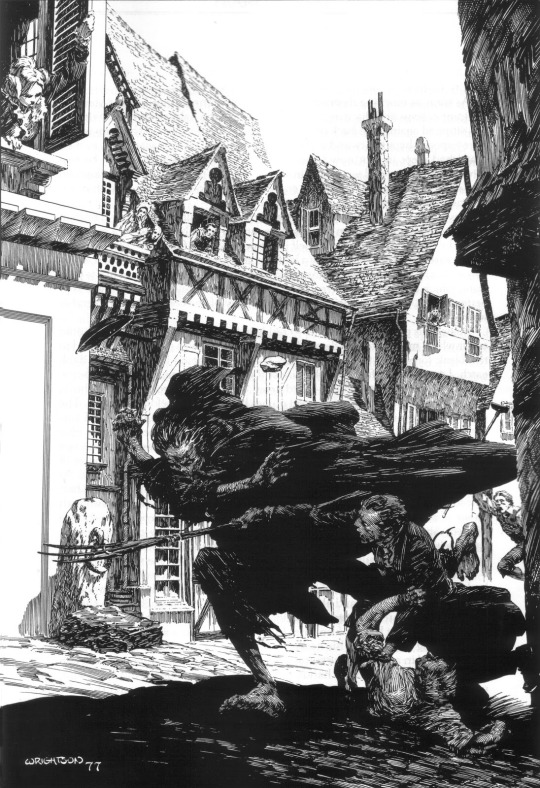
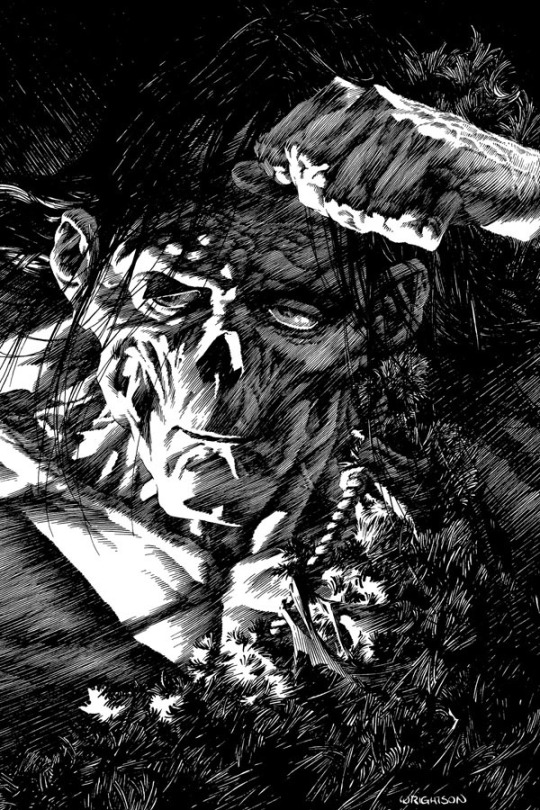
Mary Shelley’s Frankenstein illustrations by Bernie Wrightson part 3
2K notes
·
View notes
Text
“Darkness then came over me… as I now suppose, the light poured in upon me again”
Light and Dark symbolism in Frankenstien.
The use of light and dark in Frankenstein has caused arguments between Literary scholars as to what it can mean. Some argue that the light represents mental clarity for Frankenstein and his Monster. The light appears in moments of the novel when characters have epiphanies, when Frankenstein discovers philosophy for the first time, he announces "A new light seemed to dawn upon my mind.", when he later on creates the monster, he claims that it is as if “a sudden light broke in upon me”. These are all good moments in Frankenstein’s life and the light that comes with it help to affirm his position in the universe to himself. These moments are replicated with some other character like Walton who travels to Antarctica to discover the secrets of the universe in a place he refers to as the “Country of Eternal light”. Light is associated with change and development for our characters.
We see reference to the classic myth of Icarus and Light. They are too blinded by their own successes to understand that where there is light (positive moments in life) there is also darkness (negative moments in life). This balance is something that none of our protagonists have managed to balance. Pathetic fallacy is used with dark stormy weather after Frankenstein’s brother is killed, to help readers make connections between Darkness and Evil. Or alternatively, this scene is a vision that Frankenstein has with these dark conditions that could show the ignorance of the creator (of both the vision and the monster). The imagery was common of authors of the romantic period and is used to show the powe and beauty of the natural world. The romantic writers focused on ideas of the grandeur of the natural world and championing emotions. The modernistic element comes from ideas about the threat of advanced knowledge or scientific invention and the risks that come with it that are evidenced through the novel.
Darkness in the novel is used as a way to show the evil in life. The light within the novel links to knowledge and the pursuit of, whereas darkness shows the result of the knowledge and its downfalls. Darkness in reality cloaks what we know and what we can understand, it obscures our views just as those represented in darkness are often misunderstood in the novel. The monster hides in a hovel next to the cottage, to hide himself from the villagers who run away at his unsightly appearance, he is simply misunderstood and hides himself in the darkness away from people. This darkness can also symbolise the despair of humanity, the characters are detached from reality that they end up in the darkness at some point in their lives.
The book is subtitled “The modern Prometheus” a reference to the Greek God of fire and mischief who is punished by Zeus for giving fire to mankind. Victor, attempting to become a modern Prometheus, is certainly punished, but unlike fire, his “gift” to humanity knowledge of the secret of life remains a secret.’ This myth has often had many retellings by different people, who all said different things about the creation of man. Some argue that Prometheus is simply the god who brought fire to man, others argue that the light and fire was all that he brought. Regardless of the retelling of the myth, it is easy to see that Frankenstein is intended to be portrayed as Prometheus.
1 note
·
View note
Text




“Solitude was my only consolation - deep, dark, deathlike solitude.”
— Mary Shelley, from Frankenstein, or the Modern Prometheus.
3K notes
·
View notes